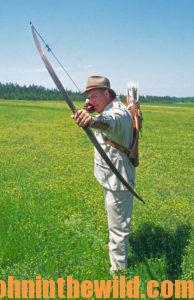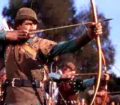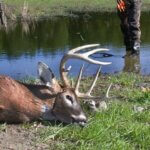 Editor’s Note: Since the days of Robin Hood and William Tell, hundreds of years have passed, millions of deer have been hunted, and thousands of hours have been invested in bowhunting technology. Archers today may feel a kinship to a particular kind of bow that’s been developed through the years, with their equipment reflecting their bowhunting heritage. The bowhunter is not simply a hunter, but is a stylist who matches his bow to his style of hunting, to his philosophies and beliefs of what bowhunting should be, and to what he feels is the best way for him personally to take deer. Bowhunting has become so diversified as a sport, that today the archer has many different options as to the kind and style of bow he’ll select, and the way he’ll hunt. What kind of bow is best for you, and what type of hunting will most satisfy you? This week, we’ll look at several different kinds of bows, their advantages and disadvantages, the styles of hunting they represent, and the types of archer who choose them.
Editor’s Note: Since the days of Robin Hood and William Tell, hundreds of years have passed, millions of deer have been hunted, and thousands of hours have been invested in bowhunting technology. Archers today may feel a kinship to a particular kind of bow that’s been developed through the years, with their equipment reflecting their bowhunting heritage. The bowhunter is not simply a hunter, but is a stylist who matches his bow to his style of hunting, to his philosophies and beliefs of what bowhunting should be, and to what he feels is the best way for him personally to take deer. Bowhunting has become so diversified as a sport, that today the archer has many different options as to the kind and style of bow he’ll select, and the way he’ll hunt. What kind of bow is best for you, and what type of hunting will most satisfy you? This week, we’ll look at several different kinds of bows, their advantages and disadvantages, the styles of hunting they represent, and the types of archer who choose them.
 The Longbow:
The Longbow:
Is the longbow a dinosaur in today’s Space Age? Does it really have a place in the world of compounds, overdraws and arrows that fly faster that 300 feet per second? The answer is definitely yes. Don’t forget that some of the greatest archery shots ever made were performed with the longbow by Howard Hill of Vincent, Alabama. With his longbow, Hill took numerous animals of each species of North America big game, as well as many African big game animals. He also was the first white man to ever down an elephant with a bow and arrow. Hill took a charging lioness with his longbow and shot an apple off a man’s head, so we know that the longbow in the hands of a master shooter can be very accurate and deadly. But the longbow may be difficult to learn to shoot.
 Here’s a description of the hunter who prefers the longbow for hunting from a friend of mine. “The longbow hunter usually falls into one of three categories,” he told me. “Either he started shooting a longbow and never changed, he shot a recurve bow for awhile and decided to try a long bow, or he shot a compound for several years and wanted to shoot a bow that was more challenging and traditional. The longbow hunter believes that when he takes a deer with his bow, he’s accomplished more than if he bags that same deer with a compound or an overdraw. Shooting one captures some of the romance of the sport; the bowman hunting with a longbow has taken a deer like the Indians once did. He also calls to mind the men who dressed in Lincoln green and hunted in Sherwood Forest. The tradition and history of hunting with a bow are captured when the archer takes a longbow into the forest.”
Here’s a description of the hunter who prefers the longbow for hunting from a friend of mine. “The longbow hunter usually falls into one of three categories,” he told me. “Either he started shooting a longbow and never changed, he shot a recurve bow for awhile and decided to try a long bow, or he shot a compound for several years and wanted to shoot a bow that was more challenging and traditional. The longbow hunter believes that when he takes a deer with his bow, he’s accomplished more than if he bags that same deer with a compound or an overdraw. Shooting one captures some of the romance of the sport; the bowman hunting with a longbow has taken a deer like the Indians once did. He also calls to mind the men who dressed in Lincoln green and hunted in Sherwood Forest. The tradition and history of hunting with a bow are captured when the archer takes a longbow into the forest.”
Other hunters name some other advantages that have made longbows popular. Longbows are rugged. You can beat them on the side of a tree and still go out and shoot them. With no moving parts, longbows are also quiet, and there’s nothing to lose when shooting one, because all you have is the string, the bow and the arrow. The biggest disadvantage of using a longbow is that because it is so long, it can be hard to maneuver, if you’re hunting in close places, and the limbs may touch something, so that you can’t aim properly. If you’re kneeling to shoot, you may have to drastically cant the bow to get off a shot, keeping in mind that 64 inches is considered a short longbow. A longbow is also not as easy to shoot as a compound. More strength is required to pull it back to full draw. But the longbow will throw a heavier arrow straighter and further than a compound will. So, don’t sell it short. Longbows have taken a lot of deer. They still bag many deer every year, and they’ll take numbers of deer in the future.
The Recurve:
The recurve bow got its name from its shape. The center will curve toward you, and the end of the limbs will curve away from you, making the recurve very powerful without requiring a lot of strength of the shooter. My hunter friend explains that, “The recurve is somewhat smoother to draw than the longbow, and it’s shorter, averaging about 60 inches in length. The arrows for these bows, especially aluminum arrows, shoot faster than the arrows for the longbow. Since longbow shooters are traditionalists, they usually choose wooden arrows, whereas recurve bowhunters often prefer aluminum shaft arrows. I think the advantage of the recurve over the longbow is the little curve on the tip of the bow, which acts as one more catapult to throw the arrow faster than a longbow can. Since recurves are longer than the average compound, a 60-pound recurve takes a fairly-strong shooter to draw and release it. A novice bowhunter once asked me when does the recurve break down, referring to the let-off that a bowhunter experiences when he’s shooting a compound. I told him, ‘As soon as you turn loose of the arrow.’
 “The basic disadvantage with both the longbow and the recurve is that the hunter must draw the bow and release the arrow as soon as he’s at full draw. The sportsman doesn’t have the advantage of holding the shot like he does with a compound. Most longbow and recurve archers are instinctive shooters out of necessity. Shooting either of these two bows is completely different from shooting a compound, since both require the archer to be able to pull and hold more weight than the compounds do. However, both the longbow and recurve are considered more traditional than the compound. The bowman who chooses the recurve is probably someone who started out shooting a recurve. Because this bow has been his first love, he’s never seen a need to change after he’s become proficient with it.
“The basic disadvantage with both the longbow and the recurve is that the hunter must draw the bow and release the arrow as soon as he’s at full draw. The sportsman doesn’t have the advantage of holding the shot like he does with a compound. Most longbow and recurve archers are instinctive shooters out of necessity. Shooting either of these two bows is completely different from shooting a compound, since both require the archer to be able to pull and hold more weight than the compounds do. However, both the longbow and recurve are considered more traditional than the compound. The bowman who chooses the recurve is probably someone who started out shooting a recurve. Because this bow has been his first love, he’s never seen a need to change after he’s become proficient with it.
“Recurve shooters also like the feel of the bow. Let me explain. There’s a certain feel to each type of bow. When an archer finds the feel that he likes, he’ll usually stay with that type of bow, often for the rest of his life. Another reason that an archer will choose a recurve is because he has confidence in it. The recurve bowhunter probably has taken deer with his recurve and has become very proficient with it. He’s developed the philosophy that his style of hunting allows him to bag as many, if not more, deer than his counterparts shooting compounds, and what’s not broken doesn’t need to be fixed.”
Recurve enthusiasts also mention that there’s no bow better for shooting fish than a recurve, because the archer can shoot quickly and accurately. Getting off a quick shot at a fish that you only see for an instant is often the difference between taking and not taking a fish. Moreover, if the hunter faces a charging wild boar or bear, he wants to be able to draw and shoot as fast as possible. If you draw the compound quickly, you may throw the arrow off the rest, and you may have to take a little time to aim before you shoot. But the recurve draws smoothly, quickly, and can be instantly released.
To learn more about bowhunting, check out John E. Phillips’ book, “Bowhunting Deer; The Secrets of the Pros,” available in Kindle and print versions at http://amzn.to/VBr1qW
Tomorrow: The Compound and the Crossbow for Bowhunting
















